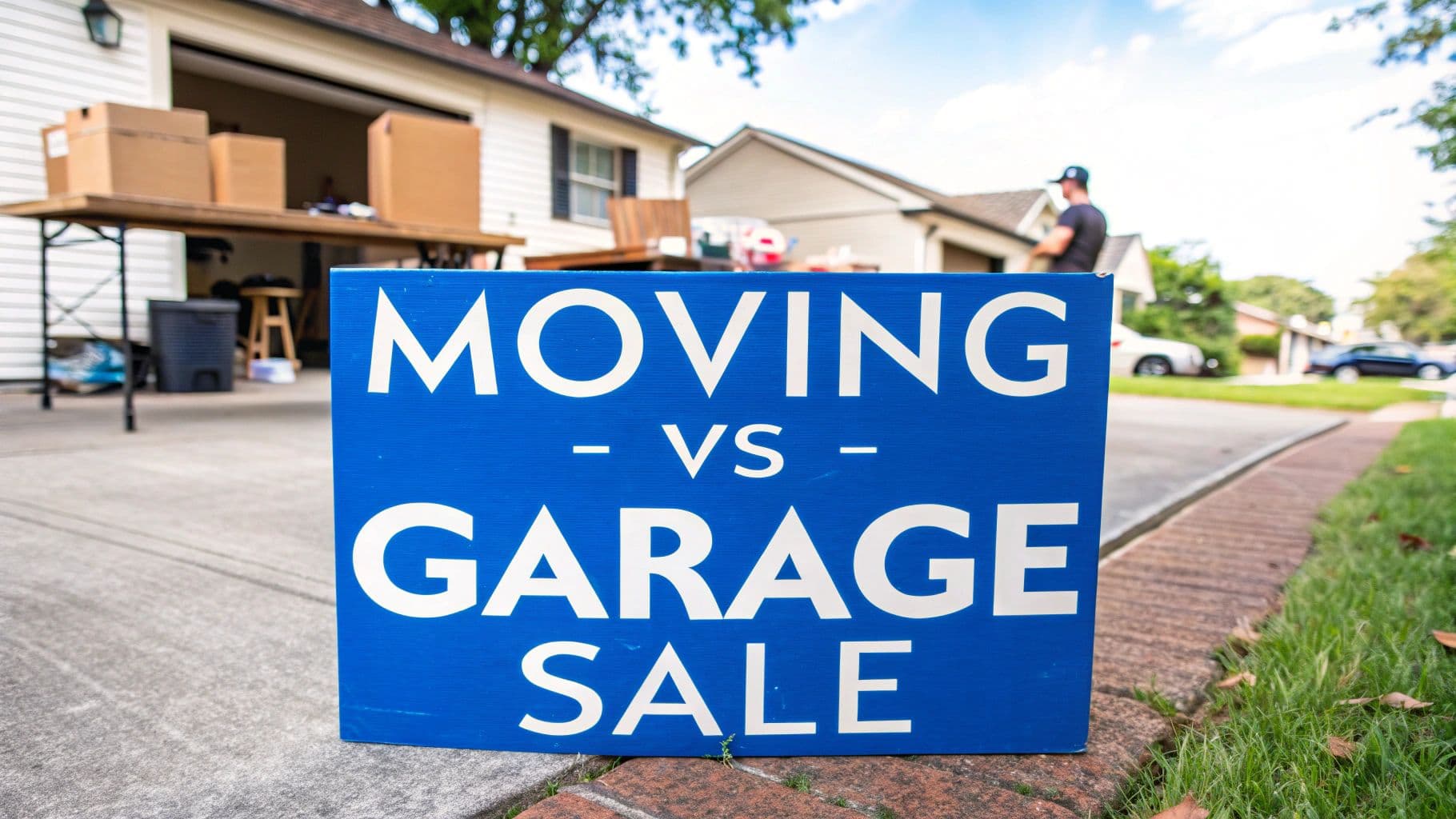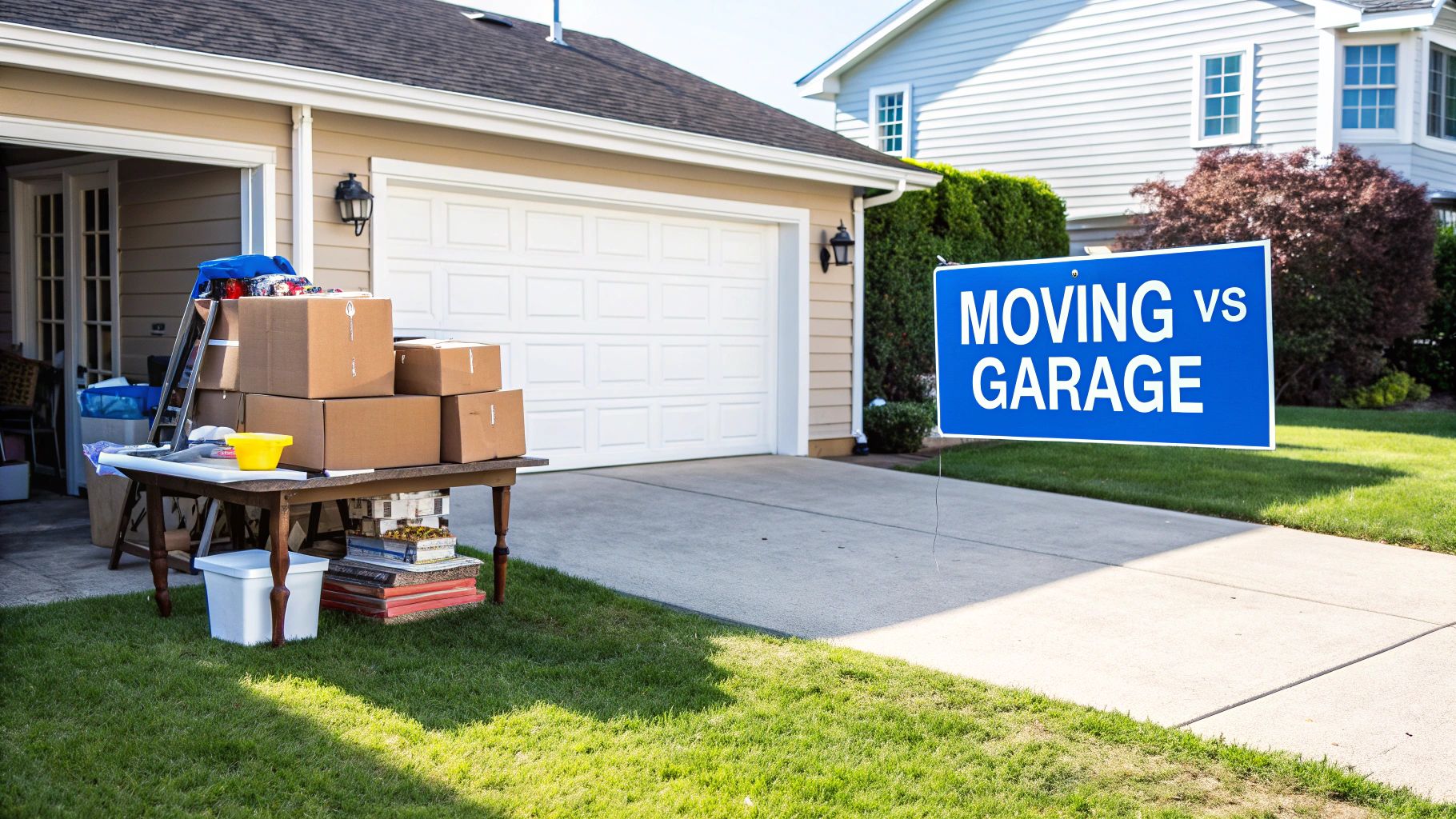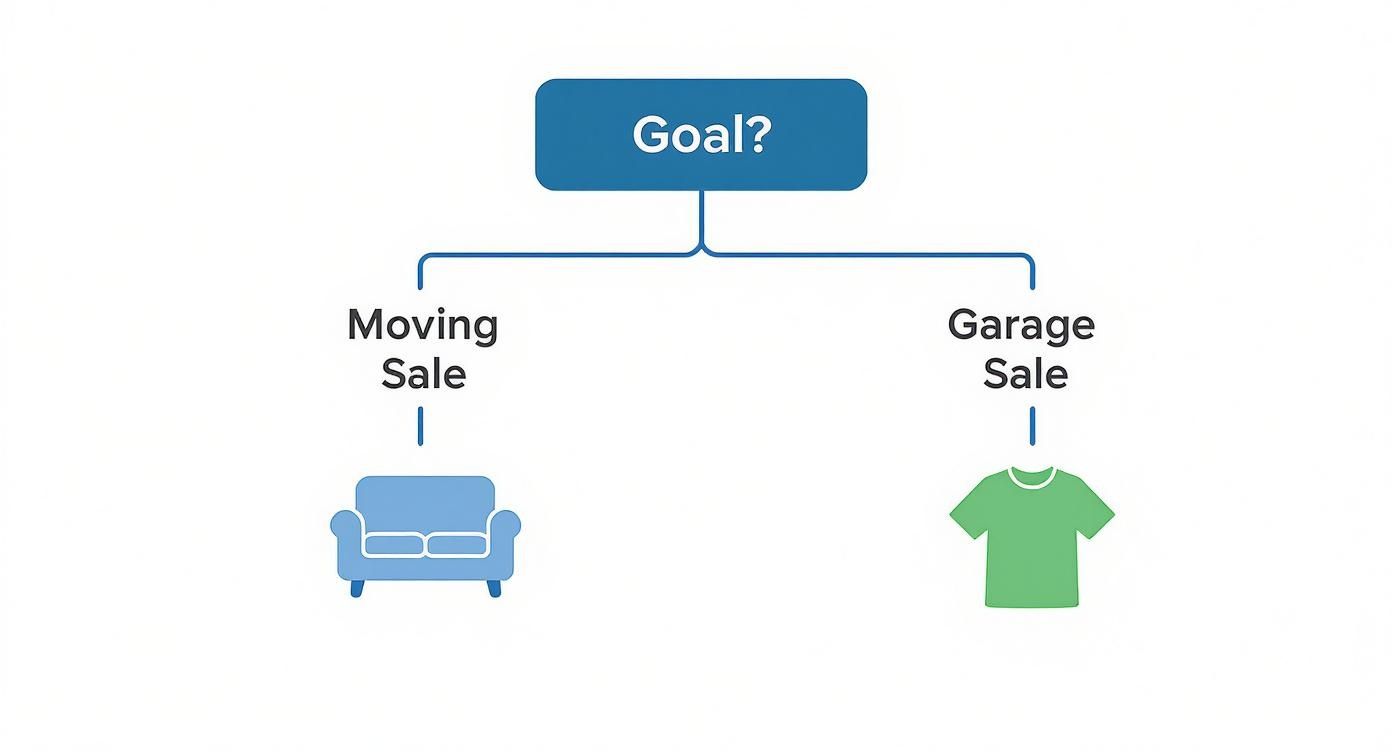Moving Sale vs Garage Sale A Definitive Comparison

At the heart of it, the difference is simple: a moving sale is a high-stakes, get-it-gone-now event driven by the urgent need to liquidate nearly everything before you move. A garage sale, on the other hand, is a much more casual, low-pressure way to declutter and make some extra cash on a weekend.
Your choice really comes down to a single question: is your goal total clearance or casual profit?
Understanding The Fundamental Differences
Sure, both involve selling your stuff from your home, but that's where the similarities end. Their purpose, scope, and how you pull them off are worlds apart. A moving sale is a project born from pure necessity, with a hard deadline that dictates every single decision. The main goal isn't to make a fortune; it's to drastically shrink the mountain of things you have to pack and haul, making your move cheaper and a whole lot easier.
A garage sale? That’s an event of choice. It’s a weekend project you decide to take on to finally clear out the attic, basement, or, well, the garage. The motivation isn't a moving truck looming in the driveway, but a desire to get organized, thin out certain categories of items, and pocket a little extra spending money.
Core Distinctions to Consider
Grasping these core differences is the first step in picking the right path for you. A moving sale often means selling big-ticket items like furniture, major appliances, and sometimes the entire contents of a room. This demands aggressive, "everything must go" pricing to make sure it all finds a new home.
Garage sales usually feature a more edited collection of things—outgrown kids' clothes, old toys, duplicate kitchen gadgets, and forgotten hobbies. This allows you to be a bit firmer on your prices.
The real game-changer is the mindset. For a moving sale, success means an empty house; every unsold item feels like a failure. For a garage sale, success is measured in cash; every single sale is a win.
This fundamental difference in purpose shapes everything else, from how you advertise to the sheer amount of effort involved. To make it even clearer, let's look at a quick side-by-side comparison.
Moving Sale vs Garage Sale At A Glance
This table breaks down the key attributes of each sale type, helping you see at a glance which one aligns with your situation.
| Factor | Moving Sale | Garage Sale |
|---|---|---|
| Primary Goal | Urgent liquidation before a move | Casual decluttering and earning cash |
| Urgency | High; driven by a fixed moving date | Low; can be planned anytime |
| Inventory | Entire household contents, including large furniture | Curated selection of unneeded items |
| Pricing Strategy | Aggressive, low prices; "everything must go" | Moderate, negotiable prices; profit-focused |
| Effort Required | High; a significant logistical undertaking | Low to moderate; manageable over a weekend |
| Marketing Focus | Attracting serious buyers for big-ticket items | Drawing in local neighbors and passersby |
Seeing them laid out like this really highlights how different the planning, execution, and goals are for each.

Defining Your Primary Goal And Motivation
Before you even think about price tags or advertising, the first step in deciding between a moving sale vs. a garage sale is asking one simple question: What's my real goal here?
Being honest with yourself is the most critical part of this whole process. Your answer—your "why"—sets the strategy for everything that follows.
Is a moving truck booked and breathing down your neck? If your main objective is to drastically lighten the load you have to pack and haul, then your motivation is clearance. A successful day is measured by an emptier house, not a fatter wallet.
On the other hand, are you just looking to reclaim some space and offload things you don't use anymore, all on your own schedule? If there’s no hard deadline, your motivation is probably a mix of decluttering and profit. You’re aiming for some extra cash without the stress of a looming move-out date.
Scenario One: The Cross-Country Relocation
Picture a family getting ready for a cross-country move in just six weeks. Their home is packed with furniture, appliances, and a lifetime of accumulated stuff. Moving it all would be incredibly expensive, and a lot of it just won't work in their new place.
Their primary goal is liquidation, plain and simple. Every bulky item they sell—the couch, the dining set, the lawnmower—is a direct win. It saves them money on moving fees and saves them the back-breaking labor of packing it. Profit is nice, but the real prize is avoiding the cost and hassle of moving things they don't need. This is a classic moving sale situation, where the unwritten rule is "Everything Must Go."
Scenario Two: The Weekend Declutter Project
Now, think about a couple who just wants to clear out the garage and basement after a big spring cleaning push. They've unearthed boxes of old toys, clothes the kids have outgrown, and a bunch of duplicate kitchen gadgets. There is no moving van on the horizon.
Their motivation is all about reclaiming space and making extra cash. They can afford to be a bit more patient with their pricing and aren't heartbroken if a few things don't sell. If an item is left over, they can just donate it or pack it away for next time. This relaxed, profit-focused mindset is a perfect fit for a traditional garage sale.
Understanding your core driver is essential. A moving sale is a tactical operation to minimize moving costs and effort. A garage sale is a casual project to convert clutter into cash.
A huge part of prepping for any sale is getting organized, and applying effective home decluttering tips is often what gets the ball rolling. This step is even more crucial when you're moving. Our guide shows you exactly how to declutter before moving to make the whole thing less overwhelming.
Once you know whether you're prioritizing clearance over cash, the right choice becomes crystal clear.
Comparing Inventory Scope And Pricing Strategy

The biggest things that set a moving sale apart from a garage sale are what you’re selling and how much you’re asking for it. These two factors really get to the heart of your goal and will shape the entire event, from the general vibe to how much cash you walk away with.
Think of a moving sale as a full-scale liquidation event. You're not just offloading a few old things; you’re often trying to sell the entire contents of a home. We’re talking about the couch, the dining set, major appliances, and even the lawnmower. The scope is massive because the objective is simple: empty the house.
A garage sale, on the other hand, is a much more curated experience. The inventory is smaller, usually just the stuff you’ve decided to part with after a good spring cleaning. It’s the outgrown kids' clothes, extra kitchen gadgets, and books you’ve already read—not the core furniture you live with every day.
The Art Of Pricing For Urgency
Your pricing has to match the purpose of the sale. With a moving sale, the clock is ticking, and that means your prices need to be aggressive. The unspoken motto is "Everything Must Go," and your price tags should reflect that urgency.
Here are a few tactics that work well:
- Drastic Markdowns: Don’t be shy. Pricing items at 70-80% below their original retail cost is common and gets things moving fast.
- Bundle Deals: Grouping similar items is a great way to clear out clutter. Think a box of kitchen utensils or a stack of paperbacks for one low price.
- End-of-Day Slashing: As the sale winds down, announce a "50% off everything" deal or offer to let people "fill a bag for $10." It’s a great way to clear the last of it.
This strategy is all about volume over value. The real win is getting an item out of your house, not squeezing every last dollar out of it. It's especially critical to understand how to effectively sell furniture when moving, as leaving large pieces behind can be a costly headache.
Pricing For Profit And Patience
A garage sale gives you the breathing room for a more traditional, profit-focused pricing model. Since you aren't under a tight deadline, you can afford to be a bit firmer and wait for the right offer. You're not just trying to get rid of stuff; you're trying to get a fair price for it. To get the best results, you need effective strategies for pricing used items.
In a moving sale, your biggest competitor is the moving truck. Every unsold item represents a future cost. In a garage sale, your only competitor is a shopper’s willingness to pay your price.
Haggling is still expected at a garage sale, of course, but you’re starting from a much stronger position. You can price items closer to their actual market value and leave a smaller margin for negotiation. If something doesn't sell, it's no big deal—you can always donate it or pack it away for next time.
Analyzing The Required Logistics And Effort

Before you even think about pricing a single item, you need to have an honest talk with yourself about the time and energy you can realistically commit. When it comes to the sheer workload, the difference between a moving sale and a garage sale is night and day.
A moving sale isn't just a weekend project—it's a major operation you have to weave into the already chaotic process of relocating. This is a whole-home overhaul. You’re looking at weeks of sorting through literally everything you own, deciding the fate of items in every closet, drawer, and corner of the basement. It can be physically and emotionally draining.
A garage sale, on the other hand, is far more contained. You can usually knock out the planning and execution over a single weekend. The scope is limited to whatever clutter you decide to tackle, which makes the whole thing much more manageable and less disruptive.
The Moving Sale Marathon
Think of a moving sale as a full-blown marathon, not a quick sprint. The timeline is long, the tasks are complex, and you absolutely need a game plan to avoid getting buried under a mountain of your own stuff.
Here’s a realistic look at the effort involved:
- Sorting & Decluttering (2-3 weeks): This is the biggest time sink. You’ll be going room by room, making tough decisions under the pressure of a looming move-out date. It requires a certain level of ruthlessness.
- Cleaning & Staging (3-4 days): Every single thing you sell, from the couch to the coffee maker, needs to be cleaned and presentable. You're essentially turning your home into a temporary showroom.
- The Sale Itself (1-2 full days): Get ready for an intense, physically demanding couple of days. You'll be on your feet constantly, answering questions, haggling over prices, and helping people carry out heavy furniture.
- Post-Sale Cleanup (1-2 days): The work isn’t over when the last customer leaves. You still have to deal with what’s left—arranging donation pickups, hauling away trash, and maybe listing a few valuable items online, all while trying to pack.
A moving sale is a true test of endurance. You’re easily looking at 40+ hours of hands-on work, and that’s time you have to find while you're already stretched thin with everything else a move entails.
The Garage Sale Weekend Sprint
A garage sale is the complete opposite—it’s a quick sprint. The logistics are simpler, the emotional toll is lower, and you can compress the entire event into a few days. The goal here isn't to liquidate a household, just to clear out some specific clutter.
The whole process can be condensed quite a bit:
- Sorting & Pricing: You can typically get this done in a few evenings or over one dedicated Saturday.
- Setup: Setting up a few tables in the driveway or garage only takes a couple of hours on the morning of the sale.
- Cleanup: Boxing up leftovers for a quick donation drop-off is a simple task, and you aren’t staring down an immediate move-out deadline.
Choosing the right approach comes down to your personal capacity. Being honest about what you can handle is the key to a successful sale and, more importantly, to avoiding burnout.
Marketing Your Sale To The Right Audience
Your advertising strategy is all about connecting with the right buyer. The biggest difference between a moving sale and a garage sale comes down to the audience you need to attract—and getting this wrong means a quiet driveway and a house still full of stuff.
A moving sale is designed to bring in serious shoppers. Think first-time apartment dwellers who need a sofa, resellers hunting for inventory, or anyone looking for a deal on major items like dining sets and appliances. These folks are often willing to drive a bit farther if they think they'll find a good deal on something substantial.
On the other hand, a garage sale is a hyper-local affair. Your audience is your neighbors, people running errands nearby, and casual browsers lured in by a good sign. They’re looking for impulse buys and small curiosities, not making a special trip to furnish their home.
Reaching Your Ideal Moving Sale Shopper
To connect with serious buyers for a moving sale, your marketing has to be detailed, digital, and have a wide reach. Your main goal is to give them enough information to convince them the drive is worth it.
- Go Digital First: Use platforms like Facebook Marketplace, Craigslist, and local buy-sell groups. This is where people are actively searching for secondhand furniture and major household goods.
- Highlight the "Why": Always use the term "Moving Sale" in your headline. It immediately creates urgency and signals that you have a ton of items you need to sell.
- Showcase the Stars: Your ads absolutely must include quality photos of your best items—the couch, the washing machine, the solid wood bookshelf. These are the hooks that will draw in buyers looking for specific pieces.
A well-crafted digital ad is everything for this kind of sale. For a deeper dive, check out our guide on digital marketing for local businesses, which has some great tips that apply here, too.
Attracting the Neighborhood Garage Sale Crowd
Marketing a garage sale is all about old-school, local visibility. The goal is simple: grab the attention of people who are already close by.
The most effective marketing for a garage sale happens within a one-mile radius of your home. Clear, simple, and visible is the winning formula.
Your strategy should be straightforward and direct:
- Bold Street Signs: This is your #1 tool. Get large, bright poster boards and use a thick, dark marker. All you need is "Garage Sale," your address, and big, unmissable arrows. Place them at the main intersections leading to your street.
- Community Posts: Share the details in hyper-local online spaces like the Nextdoor app or your neighborhood's Facebook group. Keep it brief and friendly, mentioning the date, time, and general categories (e.g., "kids' clothes, tools, and home decor").
While a moving sale is a targeted event, a garage sale is much more of an informal, community affair. In fact, these small-scale sales are a massive part of the secondhand market, with millions of American households participating each year to clear clutter and earn some extra cash. You can discover more about the scale of these events and see just how big their impact is.
How to Make the Right Choice For Your Situation
Choosing between a moving sale and a garage sale really just boils down to your specific circumstances. There’s no single “better” option—it’s about picking the right tool for the job. Once you’re honest about your goals, your timeline, and just how much stuff you need to sell, the right path usually becomes pretty obvious.
To figure it out, just ask yourself a few straightforward questions. Your answers will point you in the right direction and make sure all your hard work actually pays off.
A Quick Decision Guide
Think through these prompts. They’ll help you zero in on what really matters, making the choice a lot simpler.
-
What is your absolute deadline? If you have a moving truck booked and a non-negotiable move-out date, you need the urgency of a moving sale. If you’re just clearing things out whenever you have a free weekend, a garage sale offers that casual flexibility.
-
What's the main goal here? Is the number one priority just to empty the house and avoid paying to move things you don't want? That’s a moving sale, hands down. Or are you more interested in turning some old clutter into extra cash? That’s a classic garage sale.
-
What kind of stuff are you selling? If your inventory is full of big-ticket items like furniture, appliances, and things from every single room, you'll need the scale of a moving sale. But if you're mostly selling smaller things like clothes, old toys, and books, a garage sale is more than enough.
This decision tree gives you a quick visual of how your primary goal—moving versus decluttering—lines up with the best type of sale.

As you can see, a time-crunched move naturally leads to a large-scale moving sale. A more relaxed decluttering project, on the other hand, is a perfect fit for a smaller, traditional garage sale.
Your decision really boils down to this: A moving sale is a solution to a logistical problem (clearing out an entire house). A garage sale is a weekend project to convert clutter into cash.
When you frame it that way, you can confidently pick the sale that truly serves your needs, saves you from a ton of stress, and gets you the best possible results for your situation.
Common Questions Answered
Even with the best game plan, a few specific questions always pop up. Let's tackle some of the most common ones that come up when you're weighing a moving sale against a garage sale. Getting these details right can make all the difference.
Can I Just Call It Both a Moving and Garage Sale?
Absolutely, and you probably should. Advertising your event as a “Huge Moving and Garage Sale” is a great strategy. It creates a sense of urgency that attracts serious buyers while also signaling to casual neighborhood shoppers that there are plenty of bargains to be found.
This hybrid approach gets you the best of both worlds. Just be sure to mention any big-ticket items like furniture or appliances in your ads to really draw in the people ready to spend.
What’s the Best Plan for Leftovers?
Your game plan for unsold items really hinges on how much time you have.
- For a moving sale: The clock is ticking. You need a rock-solid plan. We recommend scheduling a donation pickup for the morning after your sale ends. Anything valuable that didn't sell should be listed online immediately. The mission is to empty the house, period.
- For a garage sale: You can breathe a little. There’s no rush. You can drop off donations at your convenience over the next week or simply box things up for your next sale.
The key difference is post-sale urgency. A moving sale requires a pre-planned, immediate exit strategy for every unsold item. A garage sale allows for a more relaxed cleanup process.
Do I Actually Need a Permit?
This is the one area where you absolutely have to do your homework. The rules can vary wildly from one town to the next.
Many cities, and especially homeowners associations (HOAs), have strict rules about permits, how many sales you can have a year, and even where you’re allowed to put your signs. Always check your city’s official website or call the clerk’s office before you do anything else. A quick phone call can save you from a major headache or a fine down the road.